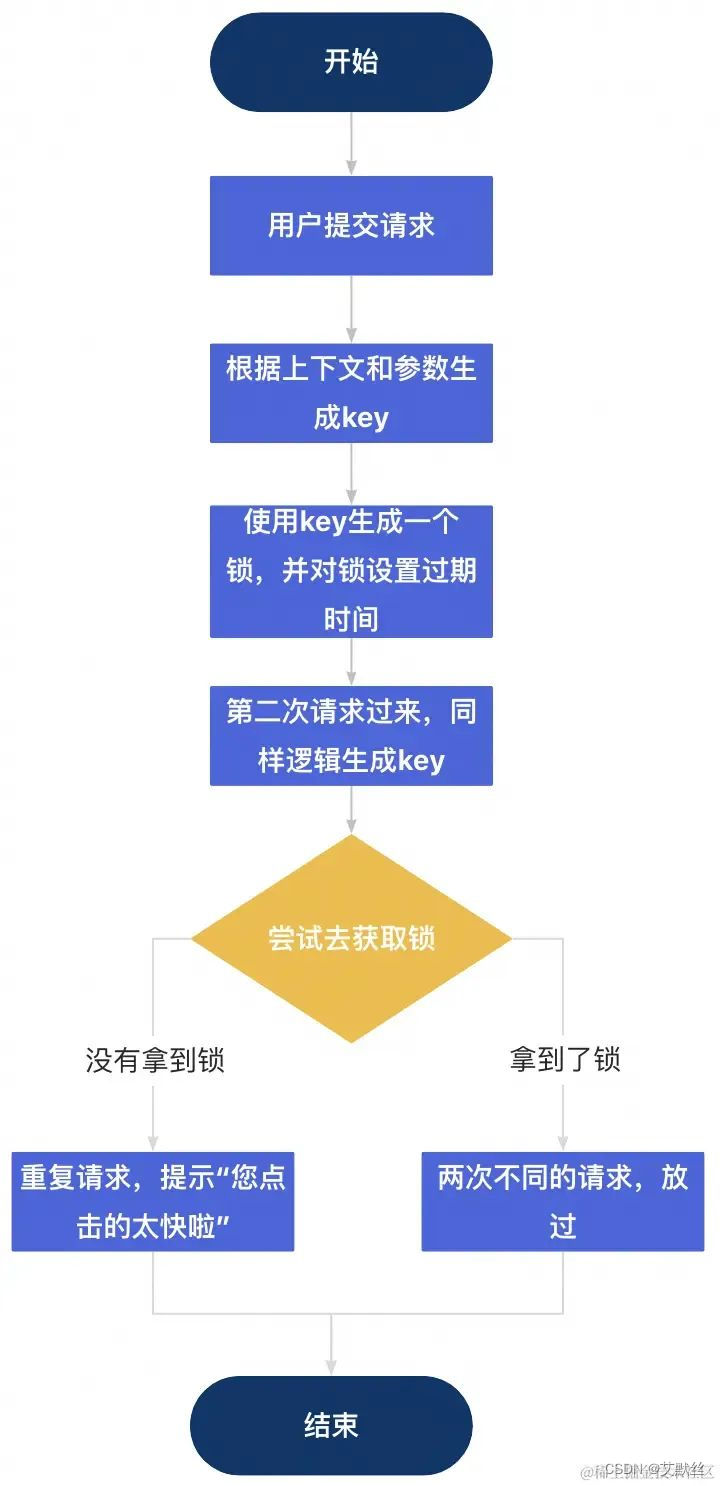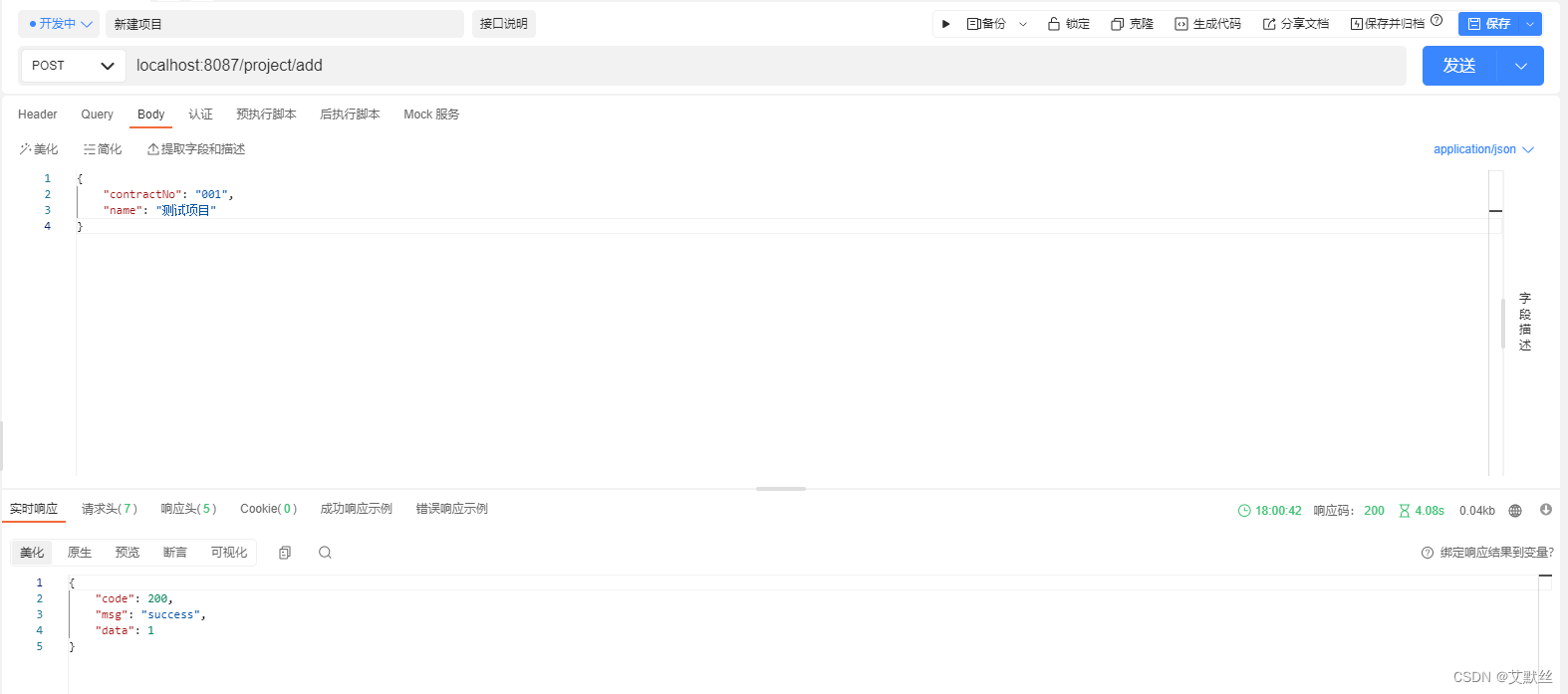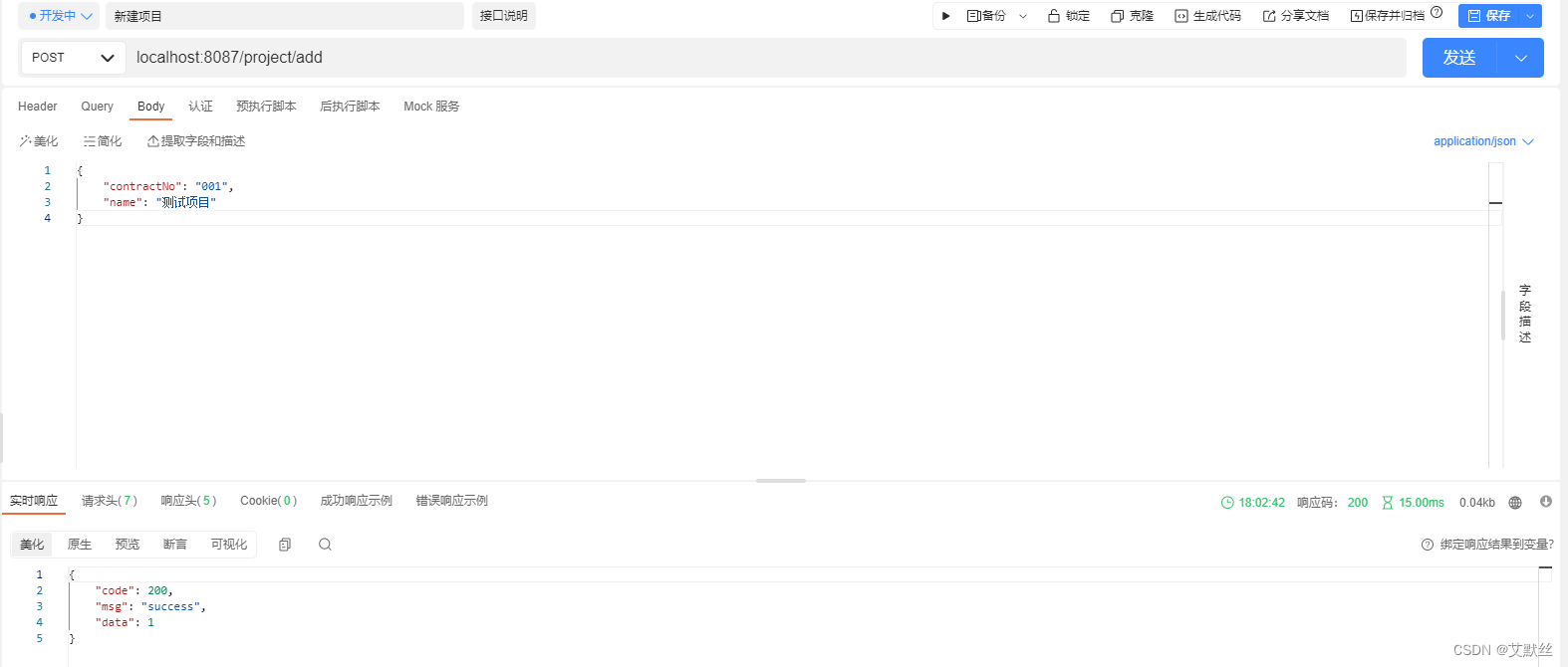- 部署springboot项目到阿里云服务器(小白包会)
- 【Rust】——项目实例:——命令行实例(一)
- com.mysql.cj.exceptions.CJCommunica
- MySQL的指令大全和注意事项(强烈推荐收藏)
- Nginx + Lua 程序脚本开发的一些配置基础及代码示例 以及 使
- IDEA2023版本创建spring boot项目时,Java版本无法
- 微信小程序使用PHP调用后台mysql数据库-小白版
- 彻底讲透:高并发场景下,MySQL处理并发修改同一行数据的安全方法
- 本地mysql5.7以上版本配置及my.ini
- MyBatisPlus(SpringBoot版)的分页插件
- nuxt服务端渲染注意事项及nuxt内存溢出解决
- Mybatis之批量更新数据
- 头歌实践教学平台数据库原理与应用实训答案
- MSTP协议配置(华为ensp)
- nginx重启失败:Job for nginx.service fai
- 【Mysql-12】一文解读【事务】-【基本操作四大特性并发事务问题事
- Windows 安装配置 RabbitMQ 详解
- 【SQL相关】Hive行列字符串的合并与拆分
- idea2023专业版安装破解+maven配置教程
- Golang数据类型
- 如何使用web文件管理器Net2FTP搭建个人网盘
- nginx-图片模块
- 【微服务】接口幂等性常用解决方案
- java.lang.NoClassDefFoundError: org
- 【Linux实践室】Linux高级用户管理实战指南:创建与删除用户组操
- 探索SQL深入理解数据库操作的关键概念与技巧【文末送书】
- 【算法专题】FloodFill 算法
- 踩了一堆坑,终于掌握了postgreSQL主从流的精髓
- 国产高云FPGA:OV5640图像视频采集系统,提供Gowin工程源码
- Python赋能AI数据分析开启人工智能新时代
啥是防抖?
所谓防抖,一是防用户手抖,二是防网络抖动。在Web系统中,表单提交是一个非常常见的功能,如果不加控制,容易因为用户的误操作或网络延迟导致同一请求被发送多次,进而生成重复的数据记录。要针对用户的误操作,前端通常会实现按钮的loading状态,阻止用户进行多次点击。而对于网络波动造成的请求重发问题,仅靠前端是不行的。为此,后端也应实施相应的防抖逻辑,确保在网络波动的情况下不会接收并处理同一请求多次。
一个理想的防抖组件或机制,我觉得应该具备以下特点:
- 逻辑正确,也就是不能误判;
- 响应迅速,不能太慢;
- 易于集成,逻辑与业务解耦;
- 良好的用户反馈机制,比如提示“您点击的太快了”
什么是接口幂等性?
接口幂等性是指在分布式系统中,对于相同的请求,无论请求多少次,都应该返回相同的结果。这意味着,如果请求已经处理完毕,那么重复请求应该返回相同的响应,而不应该产生额外的副作用。这种特性对于确保系统的稳定性和一致性非常重要,尤其是在处理并发请求和网络异常的情况下。在编程中,可以通过一些特定的设计来实现接口幂等性,例如使用全局唯一的ID来标记请求,或者使用乐观锁机制来防止重复处理等。
分布式部署下如何做接口防抖?
使用分布式锁,流程图如下:

常见的分布式组件有Redis、Zookeeper等,但结合实际业务来看,一般都会选择Redis,因为Redis一般都是Web系统必备的组件,不需要额外搭建。
具体实现
现在有一个添加项目的接口
/** * 添加项目 * @param reqVO * @return */ @PostMapping(path = "/add") public ResultqueryScanCodeSwitch(@RequestBody ProjectReqVO reqVO) { return Result.success(projectInfoService.createProject(reqVO)); } ProjectReqVO.java
package com.example.springbootaopredis.dto; import lombok.Data; /** * 项目管理 新增 VO * */ @Data public class ProjectReqVO { /** * 合同编号 */ private String contractNo; /** * 项目名字 */ private String name; /** * 项目状态 */ private Integer status; }幂等注解
根据上面的要求,我定义了一个注解@Idempotent,使用方式很简单,把这个注解打在接口方法上即可。
Idempotent.java
package com.example.springbootaopredis.util; import java.lang.annotation.ElementType; import java.lang.annotation.Retention; import java.lang.annotation.RetentionPolicy; import java.lang.annotation.Target; import java.util.concurrent.TimeUnit; /** * @Author: zcg * @Description: 幂等注解 * @Date: 2024/3/12 **/ @Target({ElementType.METHOD}) @Retention(RetentionPolicy.RUNTIME) public @interface Idempotent { /** * 幂等的超时时间,默认为 1 秒 * * 注意,如果执行时间超过它,请求还是会进来 */ int timeout() default 1; /** * 时间单位,默认为 SECONDS 秒 */ TimeUnit timeUnit() default TimeUnit.SECONDS; /** * redis锁前缀 * @return */ String keyPrefix() default "idempotent"; /** * key分隔符 * @return */ String delimiter() default "|"; /** * 提示信息,正在执行中的提示 */ String message() default "重复请求,请稍后重试"; }@Idempotent 注解定义了几个基础的属性,redis锁时间、redis锁时间单位、redis锁前缀、key分隔符、提示信息。其中前面三个参数比较好理解,都是一个锁的基本信息。key分隔符是用来将多个参数合并在一起的,比如name是测试项目,contractNo是001,那么完整的key就是"测试项目|001",最后再加上redis锁前缀,就组成了一个唯一key。
这里有些同学可能就要说了,直接拿参数来生成key不就行了吗?额,不是不行,但我想问一个问题:如果这个接口参数有富文本,你也打算把内容当做key吗?要知道,Redis的效率跟key的大小息息相关。所以,我的建议是选取合适的字段作为key就行了,没必要全都加上。
要做到参数可选,那么用注解的方式最好了,注解如下RequestKeyParam.java
package com.example.springbootaopredis.util; import java.lang.annotation.Documented; import java.lang.annotation.ElementType; import java.lang.annotation.Inherited; import java.lang.annotation.Retention; import java.lang.annotation.RetentionPolicy; import java.lang.annotation.Target; /** * @description 加上这个注解可以将参数设置为key */ @Target({ElementType.METHOD, ElementType.PARAMETER, ElementType.FIELD}) @Retention(RetentionPolicy.RUNTIME) @Documented @Inherited public @interface RequestKeyParam { }这个注解加到参数上就行,没有多余的属性。
接下来就是lockKey的生成了,代码如下RequestKeyGenerator.java
package com.example.springbootaopredis.util; import org.aspectj.lang.ProceedingJoinPoint; import org.aspectj.lang.reflect.MethodSignature; import org.springframework.util.ReflectionUtils; import org.springframework.util.StringUtils; import java.lang.annotation.Annotation; import java.lang.reflect.Field; import java.lang.reflect.Method; import java.lang.reflect.Parameter; /** * @Author: zcg * @Description: 生成LockKey * @Date: 2024/3/12 **/ public class RequestKeyGenerator { /** * 获取LockKey * * @param joinPoint 切入点 * @return */ public static String getLockKey(ProceedingJoinPoint joinPoint) { //获取连接点的方法签名对象 MethodSignature methodSignature = (MethodSignature)joinPoint.getSignature(); //Method对象 Method method = methodSignature.getMethod(); //获取Method对象上的注解对象 Idempotent idempotent = method.getAnnotation(Idempotent.class); //获取方法参数 final Object[] args = joinPoint.getArgs(); //获取Method对象上所有的注解 final Parameter[] parameters = method.getParameters(); StringBuilder sb = new StringBuilder(); for (int i = 0; i < parameters.length; i++) { final RequestKeyParam keyParam = parameters[i].getAnnotation(RequestKeyParam.class); //如果属性不是RequestKeyParam注解,则不处理 if (keyParam == null) { continue; } //如果属性是RequestKeyParam注解,则拼接 连接符 "& + RequestKeyParam" sb.append(idempotent.delimiter()).append(args[i]); } //如果方法上没有加RequestKeyParam注解 if (StringUtils.isEmpty(sb.toString())) { //获取方法上的多个注解(为什么是两层数组:因为第二层数组是只有一个元素的数组) final Annotation[][] parameterAnnotations = method.getParameterAnnotations(); //循环注解 for (int i = 0; i < parameterAnnotations.length; i++) { final Object object = args[i]; //获取注解类中所有的属性字段 final Field[] fields = object.getClass().getDeclaredFields(); for (Field field : fields) { //判断字段上是否有RequestKeyParam注解 final RequestKeyParam annotation = field.getAnnotation(RequestKeyParam.class); //如果没有,跳过 if (annotation == null) { continue; } //如果有,设置Accessible为true(为true时可以使用反射访问私有变量,否则不能访问私有变量) field.setAccessible(true); //如果属性是RequestKeyParam注解,则拼接 连接符" & + RequestKeyParam" sb.append(idempotent.delimiter()).append(ReflectionUtils.getField(field, object)); } } } //返回指定前缀的key return idempotent.keyPrefix() + sb; } }重复提交判断
使用切面实现,IdempotentAspect.java
package com.example.springbootaopredis.util; import com.example.springbootaopredis.exception.CommonExcept; import lombok.extern.slf4j.Slf4j; import org.aspectj.lang.ProceedingJoinPoint; import org.aspectj.lang.annotation.Around; import org.aspectj.lang.annotation.Aspect; import org.aspectj.lang.reflect.MethodSignature; import org.redisson.api.RLock; import org.redisson.api.RedissonClient; import org.springframework.beans.factory.annotation.Autowired; import org.springframework.context.annotation.Configuration; import org.springframework.core.annotation.Order; import org.springframework.util.StringUtils; import java.lang.reflect.Method; /** * @Author: zcg * @Description: 幂等切面实现 * @Date: 2024/3/12 **/ @Aspect @Configuration @Order(2) @Slf4j public class IdempotentAspect { private RedissonClient redissonClient; @Autowired public IdempotentAspect(RedissonClient redissonClient) { this.redissonClient = redissonClient; } @Around("execution(public * * (..)) && @annotation(Idempotent)") public Object interceptor(ProceedingJoinPoint joinPoint) { MethodSignature methodSignature = (MethodSignature)joinPoint.getSignature(); Method method = methodSignature.getMethod(); Idempotent idempotent = method.getAnnotation(Idempotent.class); if (StringUtils.isEmpty(idempotent.keyPrefix())) { throw new CommonExcept("重复提交前缀不能为空"); } //获取自定义key final String lockKey = RequestKeyGenerator.getLockKey(joinPoint); // 使用Redisson分布式锁的方式判断是否重复提交 RLock lock = redissonClient.getLock(lockKey); boolean isLocked = false; try { //尝试抢占锁 isLocked = lock.tryLock(); //没有拿到锁说明已经有了请求了 if (!isLocked) { throw new CommonExcept(idempotent.message()); } //拿到锁后设置过期时间 lock.lock(idempotent.timeout(), idempotent.timeUnit()); try { return joinPoint.proceed(); } catch (Throwable throwable) { log.info("系统异常,", throwable); throw new CommonExcept("系统异常," + throwable.getMessage()); } } catch (Exception e) { throw new CommonExcept(e.getMessage()); } finally { //释放锁 if (isLocked && lock.isHeldByCurrentThread()) { lock.unlock(); } } } }Redisson的核心思路就是抢锁,当一次请求抢到锁之后,对锁加一个过期时间,在这个时间段内重复的请求是无法获得这个锁,也不难理解。
接下来测试一下
- 第一次提交成功

- 短时间内重复提交

- 过几秒后再次提交,添加成功

本文介绍了使用springboot和切面、redis来优雅的实现接口幂等,对于幂等在实际的开发过程中是十分重要的,因为一个接口可能会被无数的客户端调用,如何保证其不影响后台的业务处理,如何保证其只影响数据一次是非常重要的,它可以防止产生脏数据或者乱数据,也可以减少并发量,实乃十分有益的一件事。而传统的做法是每次判断数据,这种做法不够智能化和自动化,比较麻烦。而今天的这种自动化处理也可以提升程序的伸缩性。
- 短时间内重复提交
- 第一次提交成功














